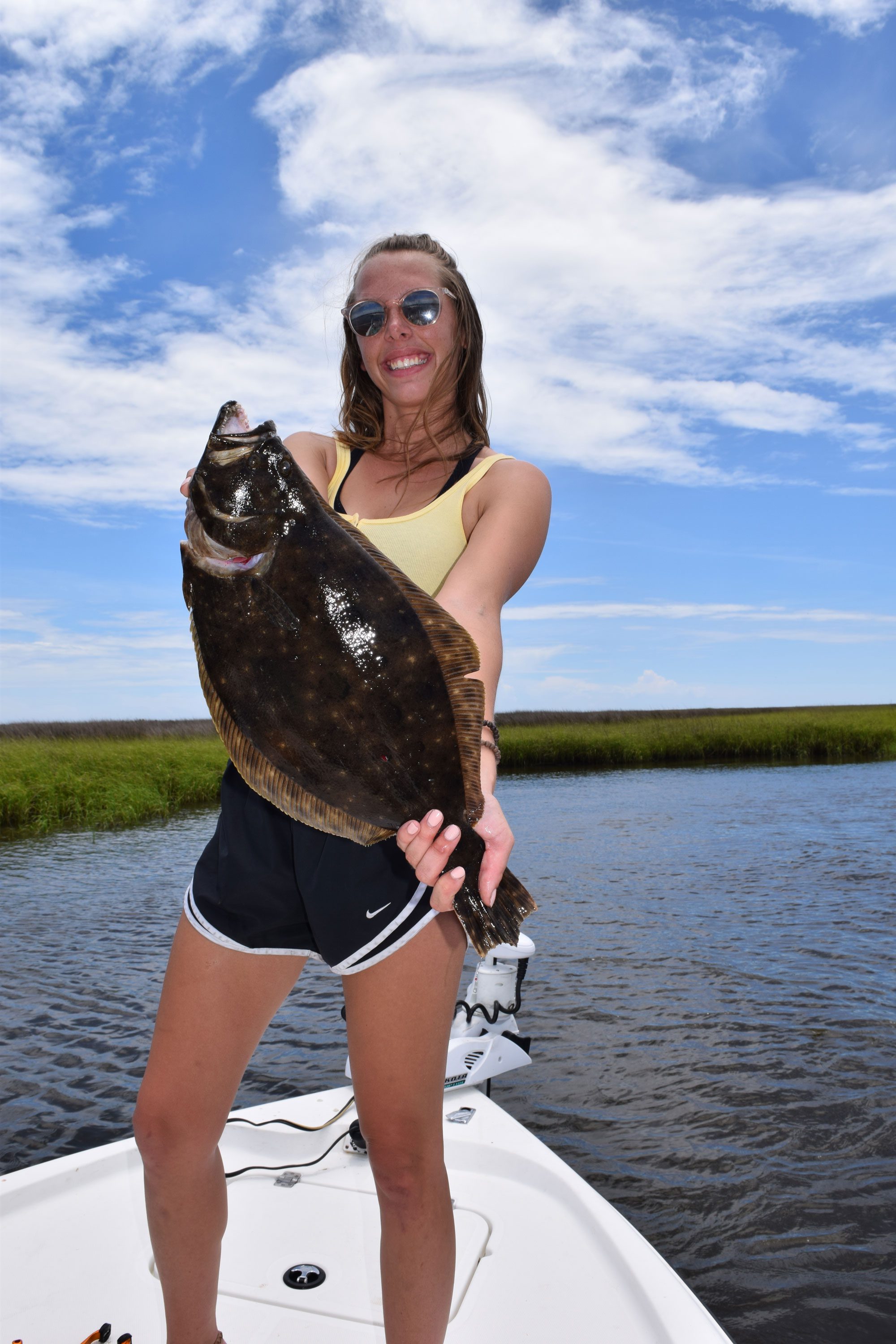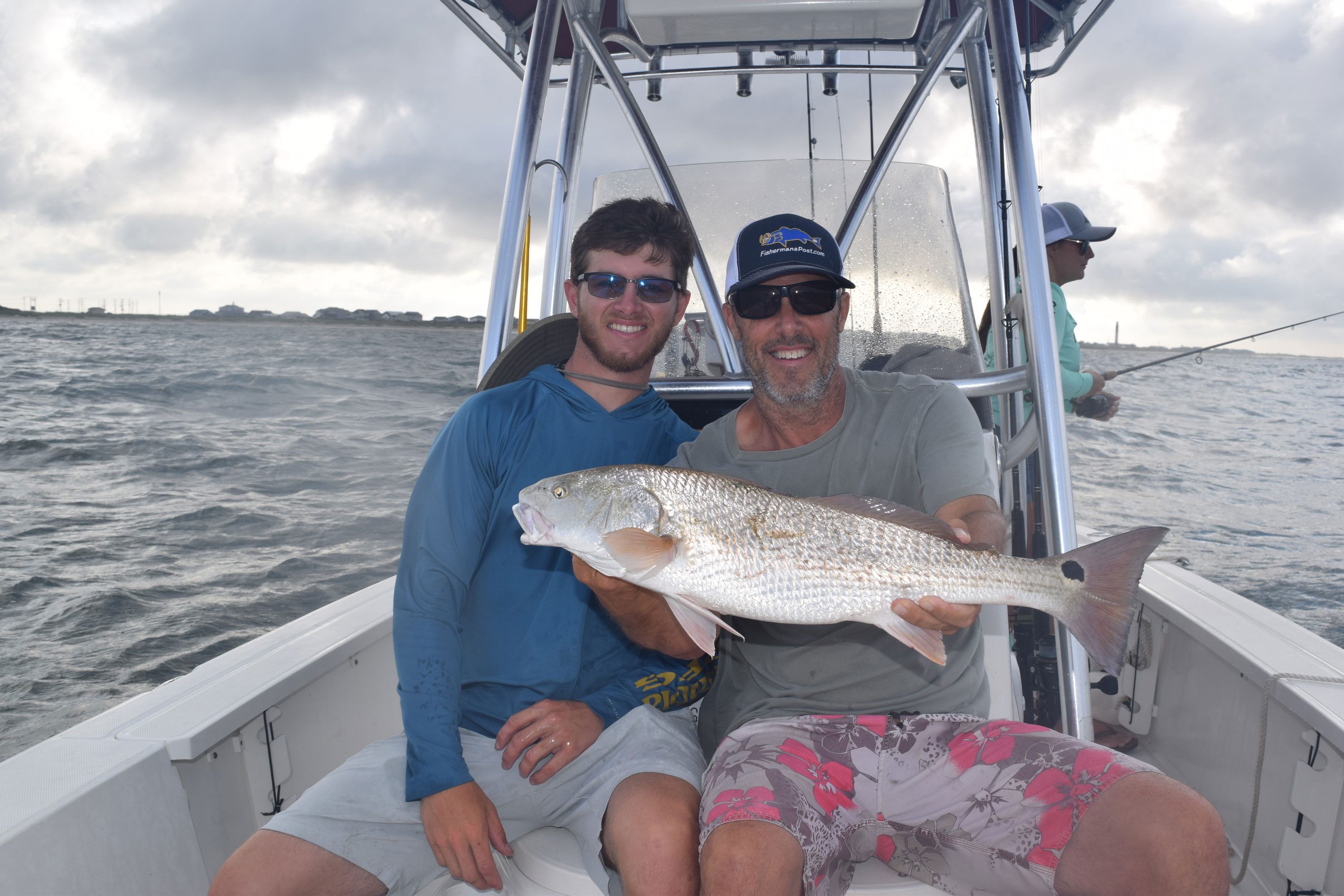Tidelines – July 4, 2019
With the future of flounder fishing in North Carolina seemingly headed for a closed season, the Fish Post crew was more than happy to head out with Capt. Robert Capps, of Reelin’ Pelican Charters, for a half day in the Southport/Oak Island targeting one of, if not the most, popular inshore species.
When Robert and I had originally put the trip in the calendar (about a month ago), the plan was to go off the beach and flounder fish all morning in the ocean. So when Robert picked us up that morning at the Wildlife boat ramp, we stayed with that original plan, even though the conditions—wind and waves—weren’t especially friendly.
Robert headed out the inlet, turned right, made his way down the beach, and pulled off plane in the vicinity of the “hot hole.” He engaged the spot lock feature on the trolling motor, armed Katelyn, Rosa, and me each with a live pogie on a Carolina rig, and gave us the simple instructions of casting out and then slowly dragging the bait back to the boat.
Our captain quickly noticed that Katelyn and I were on autopilot with the simple flounder instructions, successfully fan casting out about 15 yards or so and covering water on both sides of the boat. For Rosa, though, he saw her struggling with the cast, so he gave her the standard advice that he gives many of his clients who have little to no fishing experience.
He talked about how much line should be hanging from the rod tip to facilitate casting—too much line and the casting action gets messy and too little line and the casting action fails.
Robert also went over the basics of the bail and holding the line in place with the fingertip once the bail is flipped. That led directly into having the rod in the correct place directly behind you right before the casting motion, as well as trying to feel the load of the line and picking the right time to lift the fingertip.
Rosa still struggled with the casting motion, but she struggled less and clearly made gains.

Rosa Bestmann (Fish Post Sales Manager) with a 2.5 lb. flounder caught using a live pogie on a Carolina rig. She was fishing with Capt. Robert Capps, of Reelin’ Pelican Charters.
Our conditions were fish-able, but they weren’t comfortable, as the boat bounced around quite a bit. After an upper-slot redfish and a couple of toadfish, and Rosa not only struggling with casting but also keeping her balance, the captain made the right call to head back inside for the rest of our trip.
Inside, we started on some of the usual flounder haunts around Oak Island, Southport, and Bald Head. Our spots were varied, with some featuring structure and others offering current rips and oyster rocks, but windblown grass banks, some with shallow water and some with deeper water, seemed to be our primary target.
The grass banks offered up some short flounder, no keepers, but it also provided Rosa with time to continue to get more comfortable with the casting motion.
The challenge of casting to the grass banks wasn’t a distance challenge in that she needed to cast far, but our boat position did offer the challenge of casting a specified distance, as casts that landed closer to the grass bank would likely increase her chances of getting a bite (at least in theory, of course).
Rosa appreciated that Robert didn’t hover over her and repeatedly point out what to do differently. He had given her the basics, and then recognized that she wanted to work it out for herself.
Though most of our fish weren’t keepers, the smaller fish did give Rosa (and all of us for that matter) practice at playing the flounder bite.
Robert is from the school of “let it eat.” He believes in being very patient once you feel the flounder bite, a bite he describes to clients as a heavy sack or cloth—a weight on the line, maybe even like you’re snagged, where you won’t necessarily feel any life but maybe just weight.
The “let it eat’ philosophy comes from his days in South Brunswick High School and working with Mr. Bey in the aquaculture program. There he would watch flounder eating in the tank and seeing them come up directly behind a mud minnow or mullet minnow, go up and grab the bait, and then bring it back down to the bottom. The fish would sit with the bait, he remembers, and work it around in its mouth until the bait was pointing head first. That’s when the flounder would finally swallow the bait.
If you haven’t guessed already, this story ends with Rosa, the newbie, catching, by far, our biggest flounder of the morning.
We were near a piece of structure. Katelyn and I had each missed a couple of nice flounder bites and were working our baits back through the same areas where we had each missed the bite. Rosa had successfully cast her bait right up against the structure, but it was Robert that first noticed that her line, that had been right up against the structure, was now moving away and down the structure.

Capt. Robert Capps (left), of Reelin’ Pelican Charters out of Oak Island, and Gary Hurley with an upper-slot red drum caught on a live pogie off the beach near the “Hot Hole.”
“You got one,” he shouted. “Reel. Reel. Reel.”
She did. Rosa reeled, reeled, reeled, and she came tight to a 20+” flounder estimated at 2.5 lbs.
I’m not saying that Capt. Robert Capps, of Reelin’ Pelican Charters, can produce a 2+ lb. flounder for everyone that has never caught a flounder before, but I am saying that he made it happen on our day.
If you’d like to get in a half day or full day of flounder fishing in arguably the flounder capital of North Carolina, then it’s as easy as giving Robert a call at (910) 431-5341, or you can visit him online at www.reelinpelican.com.
And if you can’t fit that flounder trip in before the looming flounder closure in late August, then just ask him about red drum and trout, or Reelin’ Pelican also has an offshore boat for targeting kings, mahi, and other pelagics.
